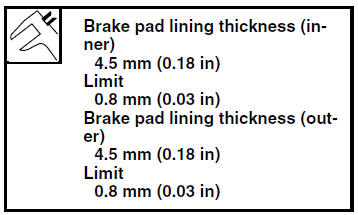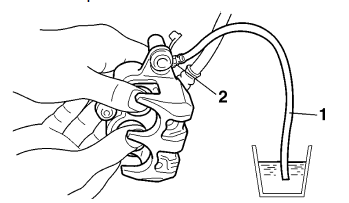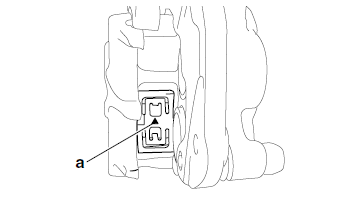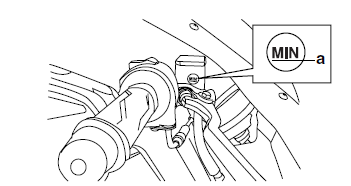Yamaha YZF-R125 Service Manual: Replacing the front brake pads
NOTE:
When replacing the brake pads, it is not necessary to disconnect the brake hose or disassemble the brake caliper.
1. Measure:
- Brake pad wear limit "a"
Out of specification
 Replace
Replace
the brake pads as a set.

2. Install:
- Brake pad support

- Brake pad spring

- Brake pads

NOTE:
Always install new brake pads, a new brake pad spring and a new brake pad support as a set.
a. Connect a clear plastic hose "1" tightly to the bleed screw "2". Put the other end of the hose into an open container.

b. Loosen the bleed screw and push the brake caliper pistons into the brake caliper with your fingers.
c. Tighten the bleed screw. 
d. Install new brake pad support, a new brake pad spring and new brake pads.
NOTE:
The arrow mark "a" on the brake pad spring must point in the direction of disc rotation.

3. Install:
- Brake pad pin
- Brake pad clips
- Front brake caliper

4. Check:
- Brake fluid level
Below the minimum level mark "a" → Add
the
recommended brake fluid to the proper level.
Refer to "CHECKING THE BRAKE FLUID LEVEL" on page 3-18.

5. Check:
- Brake lever operation
Soft or spongy feeling
 Bleed
Bleed
the brake system.Refer to "BLEEDING THE HYDRAULIC BRAKE SYSTEM" on page 3-20.
 Checking the front brake disc
Checking the front brake disc
1. Remove:
Front wheel
Refer to "FRONT WHEEL" on page 4-6.
2. Check:
Brake disc
Damage/galling Replace.
3. Measure:
Brake disc deflection
Out of specification Correct the
b ...
 Removing the front brake caliper
Removing the front brake caliper
NOTE:
Before disassembling the brake caliper, drain
the brake fluid from the entire brake system.
1. Remove:
Brake hose union bolt "1"
Copper washers "2"
Brake hose "3"
NOTE:
Put the en ...
Other materials:
Adjusting the clutch cable free play
1. Check:
Clutch cable free play "a"
Out of specification Adjust.
2. Adjust:
Clutch cable free play
a. Pull back the rubber cover "1"
b. Loosen the locknut "2".
c. Turn the adjusting bolt "3" in direction "a" or
"b" until the specified clutch cable free play is
obtained.
...
Checking the condition of the bulb sockets
The following procedure applies to all of the bulb
sockets.
1. Check:
Bulb socket (for continuity)
(with the pocket tester)
No continuity Replace.
NOTE:
Check each bulb socket for continuity in the
same manner as described in the bulb section,
however, note the following.
a. Install a ...
Checking the rear shock absorber assembly
1. Check:
Rear shock absorber rod
Bends/damage Replace the rear
shock
absorber assembly.
Rear shock absorber
Oil leaks Replace the rear
shock absorber
assembly.
Spring
Damage/wear Replace the
rear shock absorber
assembly.
Bushing
Damage/wear Replace the rea ...
